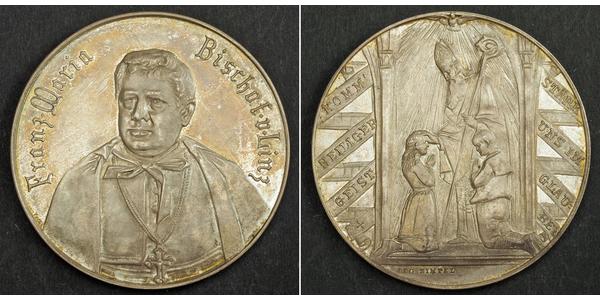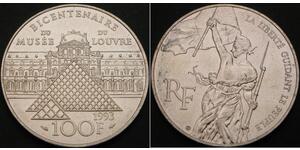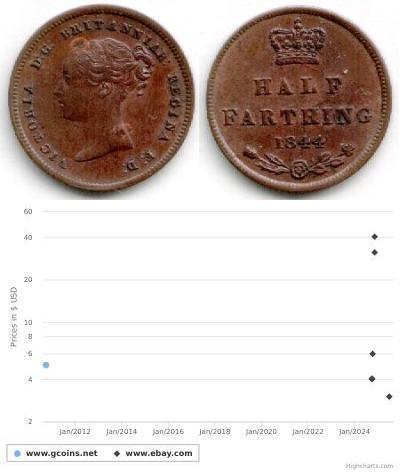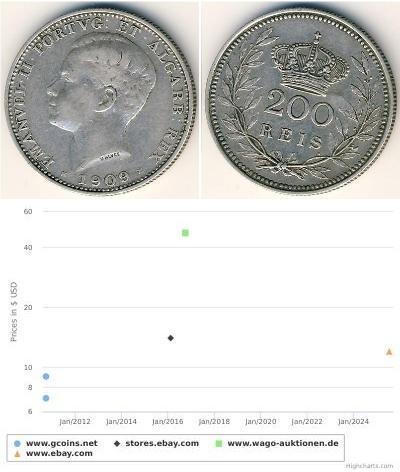(sold for $34.0)
1908, Austria, Linz, Archbishop Franz Maria Doppelbauer Silver Confirmation Medal. UNC!
Mint Place: Vienna Medallist: Leo Zimpel Mint Period: 1889-1908 References: Hauser 7123, Wurzbach 1696. Condition: Lightly toned, otherwise a nice proof-like UNCirucualted! Denomination: Confirmation Medal - Archbishop Franz Maria Doppelbauer Weight: 24.61gm (thaler weight!) Material: Silver (.900) Diameter: 42mm
Obverse: Robed and mitred bust of Franz Maria Doppelbauer facing, wearing a large cross. Legend: FRANZ . MARIA - BISCHOFF . V . LINZ ("Franz Maria Bishop of Linz")
Reverse: Baptismal scene inside church. A boy being, baptized by archibishop. Holy spirit above. Inscribed bands at sides. Exergue: KOMM HEILIGER GEIST - STÄRKE UNS IM GLAUBEN ("Holy Spirit - Strenghten us In Our Faith!")
Confirmation is a rite of initiation in Christian churches, (although in the Church of England and similar denominations it can be simply viewed as a reinstating of one's beliefs) normally carried out through anointing and/or the laying on of hands and prayer for the purpose of bestowing the Gift of the Holy Spirit.
There is an analogous ceremony also called Confirmation in the Jewish religion, which is not to be confused with Bar/Bat Mitzvah. The early Jewish Reformers instituted a ceremony where young Jews who are older than Bar/Bat Mitzvah age study both traditional and contemporary sources of Jewish philosophy in order to learn what it means to be Jewish. The age instituted was older than that of Bar Mitzvah because some of these topics were considered too complex for thirteen-year-old minds to grasp. Nowadays, Confirmation has gained widespread adherence among congregations affiliated with the Reform movement, but has not gained as much traction in Conservative and Orthodox Jewish groups. The way Confirmation differs from Bar Mitzvah is that Confirmation is considered a more communal confirmation of one's being Jewish, and Bar Mitzvah is more of a personal confirmation of joining that covenant. (see below section about Confirmation in Judaism)
Within Christianity, confirmation is seen as the sealing of the covenant made in Holy Baptism. In some denominations, confirmation also bestows full membership in a local congregation upon the recipient. In others, such as the Roman Catholic Church, confirmation "renders the bond with the Church more perfect", because a baptized person is already a full member.
Roman Catholics, Eastern Orthodox, Oriental Orthodox Churches, and many Anglicans view Confirmation as a sacrament. In the East it is conferred immediately after baptism. In the West, this practice is followed when adults are baptized, but in the case of infants not in danger of death it is administered, ordinarily by a bishop, only when the child reaches the age of reason or early adolescence. Among those Catholics who practice teen-aged confirmation, the practice may be perceived, secondarily, as a "coming of age" rite.
In Protestant churches, the rite tends to be seen rather as a mature statement of faith by an already baptised person. It is also required by most Protestant denominations for membership in the respective church, in particular for traditional Protestant churches. In traditional Protestant churches (Presbyterian, Methodist, Lutheran etc.) it is recognized by a coming of age ceremony. Confirmation is not practised in Baptist, Anabaptist and other groups that teach believer's baptism.
Franz Maria Doppelbauer (1845-1908) was the bishop of Linz from 1889 to 1908. He was a patron and promoter of Catholic interests in Austria. He gave encouragement to Catholic associations and the Catholic press, establishing personally a newspaper. He founded at Urfahr a seminary for boys, the Petrinum, as atraining-ground for the future clergy. The completion of the cathedral (consecrated May, 1905) was also due to his energetic efforts.

|
Posted by:
anonymous 2019-05-16 |






















